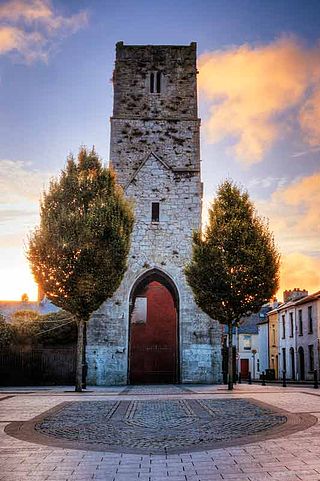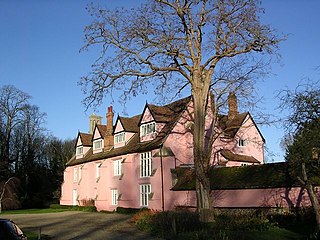Immingham Augustinian Friary was an Augustinian friary in Immingham, a town in Lincolnshire, England.
Immingham Augustinian Friary was an Augustinian friary in Immingham, a town in Lincolnshire, England.

The Red Abbey in Cork, Ireland was a 14th-century Augustinian abbey which took its name from the reddish sandstone used in construction. Today all that remains of the structure is the central bell tower of the abbey church, which is one of the last remaining visible structures dating to the medieval walled town of Cork.

Immingham is a town and civil parish in North East Lincolnshire, in Lincolnshire, England. It is situated on the south-west bank of the Humber Estuary, and is six miles northwest of Grimsby.

Clare Priory is a religious house in England, originally established in 1248 as the first house of the Augustinian Friars in England. It is situated on the banks of the River Stour, a short distance away from the medieval village of Clare, Suffolk. The friary was suppressed in 1538 and the property passed through many hands until it was again purchased by the Augustinian friars in 1953. Today the Priory offers modern retreat facilities for guests.
Events from the year 1316 in Ireland.

The Callan Augustinian Friary is an Augustinian friary situated in Callan, Co Kilkenny, Ireland. It is known locally as the "Abbey Meadow" and is located to the north-east of the town, on the banks of the Kings River. The new Augustinian Friary located in the town via the river is connected to the Abbey.
Events from the year 1540 in Ireland.
Austin Friary was an Augustinian friary in Bristol, England. It was established in 1313, when Simon de Montecute gave 100 square feet (9.3 m2) of land within the Temple Gate of Bristol. Further gifts of land were made by William de Montecute and Thomas of Berkeley during the next thirty years.
Austin Friary was a priory in Cambridge, Cambridgeshire, England. The priory was located at Peas Hill in central Cambridge from around 1289 until dissolution in 1538.
Grimsby Augustinian Friary was a friary in Lincolnshire, England.
Augustinian Friary, York was a friary in North Yorkshire, England.
Tickhill Friary was an Augustinian friary in Tickhill, South Yorkshire, England. John Clarel, a canon of Southwell, founded it about 1260. It was dissolved in 1530. The remains are a Grade II* listed monument. The 14th century buildings were converted into dwellings in the 17th century, extensions followed in the 19th century. Until 1538, the Fitzwilliam tomb was located in the friary church, but was then moved into the parish church.
Robert Wodehouse was a medieval English administrator.
Leicester Austin Friary is a former Augustinian Friary in Leicester, England.

The Augustinian Friary of the Most Holy Trinity was an Augustinian Roman Catholic Priory, founded c. 1259, by the family of Talbot on the south bank of the river, in what is now Crow Street, Dublin. At the time the priory was built, it was just outside the city walls. The Friary most likely followed the design of the parent priory Clare Priory in the town of Clare, Suffolk (England). The Friary was suppressed in 1540 when it was described as a "church with belfry, a hall and dormitory". The friars continued to operate in secret within the city. and there are several mentions of them in the city archives until the late 1700s when they consecrated a new church.
Newark Friary, also known as Newark Greyfriars, and Newark Observant Friary, was a friary of the reformed "Observant Friars" of the Franciscan Order, located in the town of Newark, Nottinghamshire, England. The friary as founded by Henry Tudor c. 1499, and dissolved by his son, Henry VIII, in 1539.

Angelo of Foligno - born Angelo Conti - was an Italian Catholic priest and a professed friar of the Order of Saint Augustine. Conti was part of the order of John the Good though became a mainstream Augustinian in 1256 after the Grand Union of the order. He was a close friend of both Saint Nicholas of Tolentino and Blessed Ugolino da Gualdo Cattaneo.